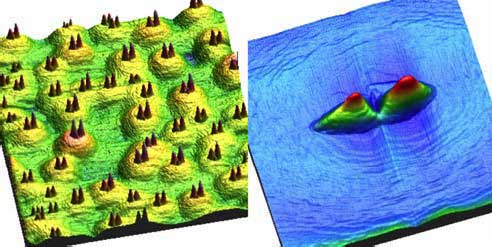| Posted: Aug 16, 2006 | |
Quantum dot molecules - one step further towards quantum computing |
|
| (Nanowerk Spotlight) Individual quantum dots (QDs) have been widely investigated for the past 15 years, showing their potential applications in quantum computing. However, individual QDs are not enough for practical applications, but preparing and characterizing groups of QDs with controllable crosstalk (quantum dot molecule) is very challenging still. University of Arkansas researchers discovered a simply way to fabricate QD pairs, the most simple QD molecule. This provides a unique opportunity to study carrier interaction among QDs, one step further towards quantum computing. | |
 | |
| Pairs of quantum dots (Reprinted with permission from Springer) | |
| Professors Zhiming Wang and Gregory Salamo, who lead the the molecular-beam-epitaxy (MBE) group at the University of Arkansas, together with co-authors Kyland Holmes, Yuriy I. Mazur and Kimberly A. Ramsey report their most recent findings in an article titled "Self-organization of quantum-dot pairs by high-temperature droplet epitaxy" published online on July 25, 2006 in the new, free-access publication Nanoscale Research Letters. | |
| "Self-assembly of epitaxial semiconductor nanostructures has been an intensive field of research" Wang explains to Nanowerk. "In particular, the Stranski-Krastanov (SK) growth mode based on the use of lattice-mismatched materials has played an important role in the formation of nanostructures, the investigation of quantum confinement effects, and has made possible applications of nanostructures." | |
| In parallel, an alternative approach for the growth of nanostructures, called "droplet epitaxy" was developed. This is the method used by the researchers at the University of Arkansas, whereby liquid metal droplets are first formed as an intermediate growth step before being converted into semiconductor nanostructures. | |
| "Recently, the approach of droplet epitaxy has shown promise to achieve the local ordering of quantum nanostructures" says Wang. "In our recent work we make use of droplet epitaxy and anisotropic surface diffusion to fabricate QD pairs." | |
| Wang explains his current research to Nanowerk: "We explored how to grow such QD pairs and why the QD pairs are formed. By forming Ga droplets and converting them into GaAs nanostructures at relatively high temperatures, we observed the evolution of QD pairs during subsequent annealing. The dramatic change in shape is caused by the anisotropy nature of surface diffusion and incorporation." | |
| The QD pairs are structurally studied by x-ray diffuse scattering (published separately in the July 31, 2006 online edition of Applied Physics Letters ("Zero-strain GaAs quantum dot molecules as investigated by x-ray diffuse scattering") and by Near-field Scanning Optical Microscopy (the manuscript is in preparation) as well. | |
| The results achieved by Wang and his colleagues are observed at a substrate temperature of 550°C which is significantly higher than previously reported droplet-related experiments (growth temperatures of 200°C or lower). This high-temperature droplet epitaxy is performed at substrate temperatures very close to normal MBE growth conditions, demonstrating high quality of GaAs/AlGaAs coherent nanostructures with excellent optical properties. | |
| "It demonstrates that high-temperature droplet epitaxy can provide a valuable opportunity to fabricate novel semiconductor nanostructures" says Wang. "We are now working to control the number, size and distance of QDs in the molecules." | |
 By
Michael
Berger
– Michael is author of three books by the Royal Society of Chemistry:
Nano-Society: Pushing the Boundaries of Technology,
Nanotechnology: The Future is Tiny, and
Nanoengineering: The Skills and Tools Making Technology Invisible
Copyright ©
Nanowerk LLC
By
Michael
Berger
– Michael is author of three books by the Royal Society of Chemistry:
Nano-Society: Pushing the Boundaries of Technology,
Nanotechnology: The Future is Tiny, and
Nanoengineering: The Skills and Tools Making Technology Invisible
Copyright ©
Nanowerk LLC
|
Become a Spotlight guest author! Join our large and growing group of guest contributors. Have you just published a scientific paper or have other exciting developments to share with the nanotechnology community? Here is how to publish on nanowerk.com.
